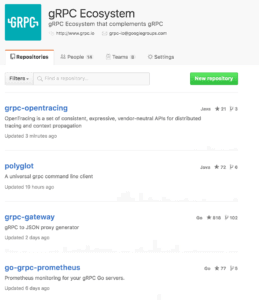CNCF is the new home for gRPC and its existing ecosystem projects (https://github.com/grpc and https://github.com/grpc-ecosystem). The sixth project voted in by CNCF’s Technical Oversight Committee (TOC), gRPC is a modern, open source, high performance remote procedure call (RPC) framework originally developed by Google that can run in any environment.
Designed to make connecting and operating distributed systems easy and efficient, Google has been using many of the underlying technologies and concepts in gRPC. The current implementation is being used in several of Google’s cloud products and externally facing APIs.
Outside of Google, there’s a growing number of public users. According to The New Stack: “Within the first year of its launch, gRPC was adopted by CoreOS, Lyft, Netflix, Square, and Cockroach Labs among others. Etcd by CoreOS, a distributed key/value store, uses gRPC for peer to peer communication and saw huge performance improvements. Telecom companies such as Cisco, Juniper, and Arista are using gRPC for streaming the telemetry data and network configuration from their networking devices.”
Developers often work with multiple languages, frameworks, technologies, as well as multiple first- and third-party services. This can make it difficult to define and enforce service contracts and to have consistency across cross-cutting features such as authentication and authorization, health checking, load balancing, logging and monitoring and tracing — all the while maintaining efficiency of teams and underlying resources. gRPC can provide one uniform horizontal layer where service developers don’t have to think about these issues and can code in their native language. (Read this Container Solutions blog for an introduction to gRPC).
“For large-scale Internet companies and high throughput storage and streaming systems where performance really matters, gRPC can shine. In addition, having a uniform framework to connect and operate cross-language services where difficult concepts like circuit breaking, flow control, authentication, and tracing are taken care of can be very useful,” said Varun Talwar, product manager at Google in charge of gRPC.
In the same New Stack article, Janakiram MSV wrote, “When compared to REST+JSON combination, gRPC offers better performance. It heavily promotes the use of SSL/TLS to authenticate the server and to encrypt all the data exchanged between the client and the server.”
Aiming to be the protocol that becomes a next-generation standard for server-to-server communications in an age of cloud microservices, recently InfoWorld reported on the 1.0 release and its ease of use, API stability, and breadth of support.
“We are excited to have gRPC be the sixth project voted in by CNCF’s Technical Oversight Committee (TOC). Being a part of the CNFC can help bolster the gRPC community and tap into new use cases with microservices, cloud, mobile and IoT,” continued Talwar.
Just a little more than one and half years old, the project already has 12K Github stars (combined), >2500 forks (combined) and >100 contributors.
“As the neutral home of Kubernetes and four additional projects in the cloud native technology space (Fluentd, Linkerd, Prometheus, and OpenTracing), having gRPC join CNCF will attract more developers to collaborate, contribute and grow into committers. We also look forward to bringing gRPC into the CNCF family by hosting a gRPC project update at our upcoming CloudNativeCon EU event,” said Chris Aniszczyk, COO, CNCF.
The move into CNCF comes with a change of license from BSD-3 license plus a patent grant to Apache v2. Read “Why CNCF Recommends ASLv2” to understand why CNCF believes this is the best software license for open source projects today.
“ASL v2 is a well-known and familiar license with companies and thus is more suitable for our next wave of adoption while likely requiring less legal reviews from new potential gRPC users and contributors,” said Dan Kohn, Executive Director, CNCF.
With a strong focus on working with existing stacks, gRPC’s pluggable architecture allows for integrations with service discovery systems like Consul, ZooKeeper, etcd, Kubernetes API, tracing and metrics systems like: Prometheus, Zipkin, Open Tracing and proxies like Proxies: nghttp2, linkerd, Envoy. gRPC also encapsulates authentication and provides support for TLS mutual auth or you can plugin your own auth model (like OAuth).

Being a part of the broader CNCF ecosystem will encourage future technical collaborations, according to Talwar.
Interested in hearing more from core gRPC developers? Look forwith a future post from Talwar on why the project joined CNCF. He’ll also talk about how the project hopes to gain new industry friends and partners to pave the way for becoming the de-facto RPC framework for the industry to adopt and build on top of. This Google Cloud Platform Podcast on gRPC with Talwar from last spring is also worth a listen.
Discuss this post on Hacker News!